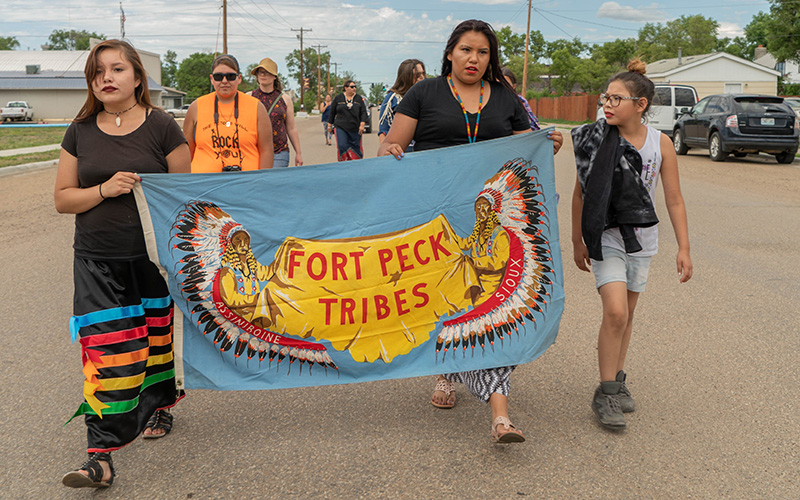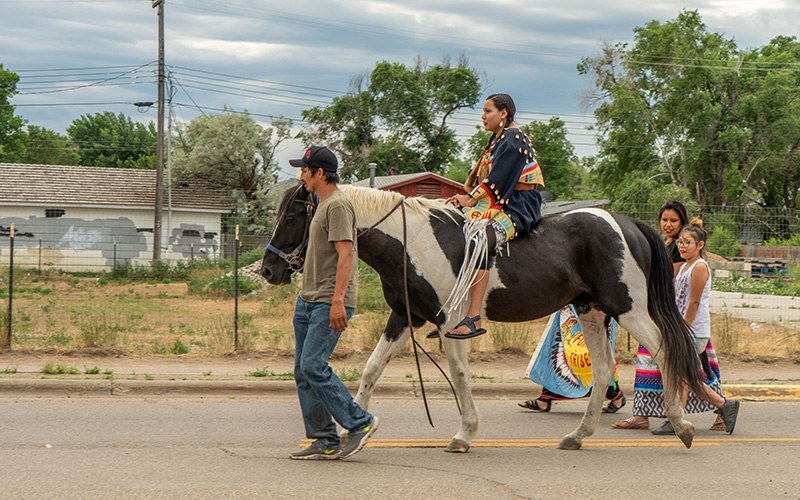MISSOULA, Mont. – Native American women across the country are being murdered and sexually assaulted on reservations and nearby towns at far higher rates than other American women. Their assailants are often white and other non-Native American men outside the jurisdiction of tribal law enforcement.
News21
This report is part of the “Hate in America” project produced by the Carnegie-Knight News21 initiative, a national investigative reporting project by top college journalism students and recent graduates from across the country and headquartered at the Walter Cronkite School of Journalism and Mass Communication at Arizona State University.
In some U.S. counties composed primarily of Native American lands, murder rates of Native American women are up to 10 times higher than the national average for all races, according to a study for the U.S. Department of Justice by sociologists at the University of Delaware and University of North Carolina, Wilmington.
Other possible victims have never been found. As of 2016, there were 5,712 cases of missing Native American women reported to the National Crime Information Center.
“The numbers are likely much higher because cases are often under-reported and data isn’t officially collected,” said the U.S. Sen. Heidi Heitkamp, a Democrat from North Dakota, who has introduced legislation to improve how law enforcement keeps track of missing and murdered indigenous women.
“(Murder and sexual assault) is a real fear amongst Native American women,” said Lisa Brunner, co-director of Indigenous Women’s Human Rights Collective and professor and cultural coordinator at White Earth Tribal and Community College in Mahnomen, Minnesota.
“Native American women are victims of violence far greater than any population in the country simply because of who we are as native women, and what we represent, our tribal nations,” Brunner said.
More than half of Native American women have been sexually assaulted, including over a third who have been raped during their lifetime – a rate of rape nearly 2.5 times higher than for white women, according to a 2016 National Institute of Justice study.
Unlike women of every other racial group, Native American women are more likely to be sexually assaulted by people who are not Native American. A study by the University of Delaware and the University of North Carolina found that more than two-thirds of sexual assaults against indigenous women are committed by white and other non-Native American people.
Yet non-native men who assault Native American women on reservations can’t be arrested or prosecuted by tribal authorities under a 1978 Supreme Court decision.
“If a white person commits murder or rape against a Native American person, the federal government would have jurisdiction over those crimes, instead of the tribe or state government,” said Cheryl Bennett, an Arizona State University professor who studies hate crimes targeting indigenous peoples.
But when tribal law enforcement sent sexual-abuse cases to the FBI and U.S. Attorney Offices, federal prosecutors declined more than two-thirds of them, according to a 2010 Government Accountability Office report.
The problem is particularly acute in the 200,000-square-mile Bakken region straddling the Montana-North Dakota state line, where attacks on Native American women have increased as tens of thousands of transient oil workers flow into temporary housing units called “man camps” on and near tribal lands.
During the last peak of production in the Bakken oil formation, ending in 2014, reported sexual assaults of women increased, according to a University of North Dakota study that analyzed data from CAWS North Dakota, a statewide sexual and domestic violence coalition. The area is home to the Assiniboine and Sioux nations of the Fort Peck Indian Reservation in Montana and the affiliated Mandan, Hidatsa and Arikara tribes, collectively known as the MHA Nation, on the Fort Berthold Indian Reservation in North Dakota.
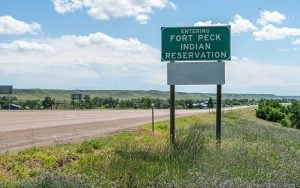
The Fort Peck Indian Reservation is in the northeastern corner of Montana. The largest community on the reservation is Wolf Point, with a population of roughly 2,600 residents. (Photo by Tilly Marlatt/ News21)
Tribal law enforcement has no jurisdiction over these workers, including those living in camps built on indigenous lands to which the federal government holds title.
“Of the million acres that are on a map that say Fort Berthold, we own less than 500,000 of that as a tribal nation, even though it’s the Fort Berthold Indian Reservation – that’s how the man camps are able to be on the reservation” said Kandi Mossett, a member of the MHA Nation and the director of the Native Energy and Climate Campaign of the Indigenous Environmental Network.
Interactions between Native Americans and non-native oil workers are inevitable she said, adding, “As far as racially motivated crimes, they feel even more like they can help themselves.”
MHA Nation victim services workers “said it was the transient workers that were committing these crimes … and with the arrival of all of these men, the rape victimization had tripled,” Lisa Brunner said. “They did not see it coming or know what was about to happen with all of these men coming up for the oil boom.”
Mosset said that community members of the MHA Nation have created Facebook pages to warn residents of dangers. “You’ll see alerts on there about a van that tried to grab three native kids driving by the elementary school,” she said. “I’ve seen four of those now, supposedly white offenders.”
After a downturn for a few years, Bakken oil production is rapidly ramping up. “The boom is picking back up again, so we’re starting to see more people moving in,” Mossett said.
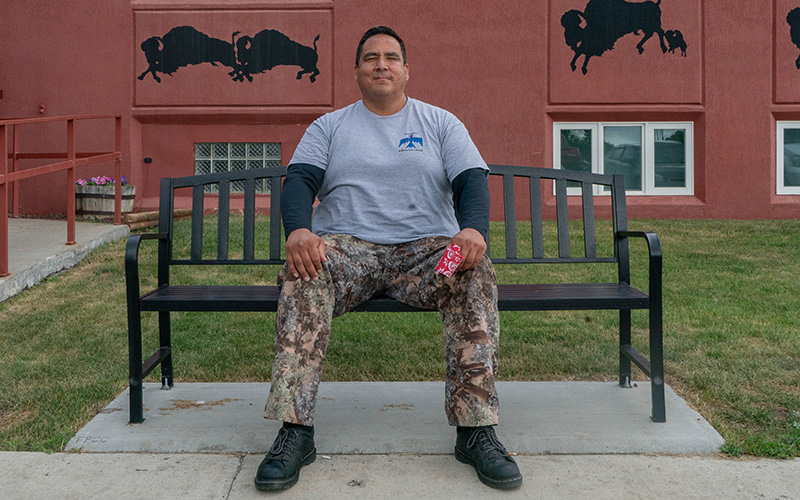
Lance Four Star is the chairman of the Fort Peck Assiniboine Council. “Historically, what has occurred in the Bakken oil field is that attracts a certain element of criminality that includes human trafficking and elicit substances, such as methamphetamine,” he said. “We’ve seen here on the Fort Peck Indian Reservation a number of cases in human trafficking.” Four Star fears that the Keystone XL pipeline could heighten these crimes. (Photo by Tilly Marlatt/News21)
Across the U.S., many Native American victims are not accounted for by law enforcement agencies, said Annita Lucchesi, a doctoral student at the University of Lethbridge in Canada. She has collected online reports and public records to create a database of more than 2,600 cases of missing and murdered indigenous women from across the U.S. and Canada. Nearly half of the victims are from the U.S.
One of Lucchesi’s former students, Ashley Loring HeavyRunner went missing in June 2017 from the Blackfeet Reservation in Montana. Her sister said she reached out to the Bureau of Indian Affairs for help, but after nine months of searching, she received no new information. The FBI didn’t step in until March 2018, she added. Over a year since her disappearance, Loring HeavyRunner is still missing.
“Ashley was very bright,” Lucchesi said. “She was really proud to be Blackfeet. She loved her people. She loved her culture. She planned on transferring to the University of Montana with her sister in Missoula to study environmental science then to come back home and take care of her homelands.”
“We live in a society where portrayals of indigenous women are often as victims of violence or hypersexualized,” Lucchessi said. “When the rest of the country only thinks of native women in those ways, it’s easy to see us in real life as women who are easy to victimize.”
Lucchesi said she was once raped by a non-indigenous man who made comments about her looking like Pocahontas, even though they look nothing alike, she said.
She also recalled that later, when she was walking through Spokane, Washington, on her way back from a concert with her friends, she was confronted by a white man who insisted on paying them for sex.
“Thank God my friend had a baseball bat in the car,” Lucchesi said. “He was following us, screaming at us, offered us 50 bucks each and said, ‘That’s a lot for Indian girls, you’re not even worth that much,'” Lucchesi said. “It was all based on a stereotype of who we are as native women.”
ASU professor Bennett has researched the race of perpetrators and the use of racist slurs during sexual assaults targeting indigenous women. She believes that they should be considered in most cases to be hate crimes.
More than 2,000 Native Americans live in Missoula, which sits south of Flathead Nation nestled between rolling mountain ranges. One of those residents was Lonette Keehner, 56, a member of the Blackfeet Nation in Montana, who worked as a housekeeper at the Super 8 Motel near her home.
Her two children remember her as a loving mother and hard worker.
“She never called in sick, and whenever they were short-handed, Super 8 would call her in on her days off and she had no problem going in,” said Keehner’s son, David.
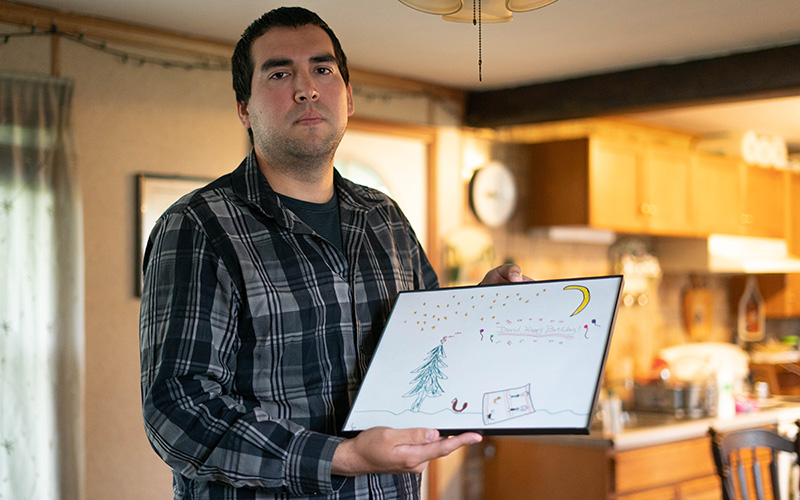
David Keehner holds up a picture his mother, Lonette Keehner, drew for him. She was murdered by two people who have white-supremacist beliefs but the killing was not prosecuted as a hate crime. (Photo by Tilly Marlatt/News21)
On Dec. 21, 2015, while Keehner cleaned a suite at the Super 8, Scott Price and Sarah McKnight entered the room, demanding the keys to Keehner’s red 2009 Chevrolet Malibu, according to court documents. When McKnight left to start the vehicle, Price assaulted Keehner, stole her master key to the hotel and forced her into a new room, where he stabbed her multiple times, killing her.
Price and McKnight made it to Coeur d’Alene, Idaho, where local law enforcement found them in a motel.
Price has the numbers “14” and “88” tattooed on his neck, with 14 representing the “14 Words” slogan (“We must secure the existence of our people and a future for white children”). The figure 88 signifies “Heil Hitler” because H is the eighth letter of the English alphabet. McKnight has six swastikas and an “88” on various parts of her body. She also has the word “Aryan” tattooed on her left index finger.
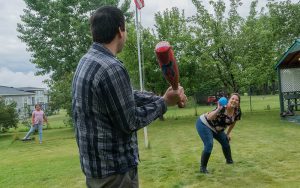
Nicole Walksalong (right) plays with her brother, David Keehler, and her daughter, Christiana, in the backyard of her mother’s former home in Missoula. Nicole recalls having long conversations with her mother, Lonette Keehner, who was murdered in 2015. (Photo by Tilly Marlatt/News21)
During the investigation, McKnight said Price killed Keehner because she was Native American, according to a court report. Another record shows that they both expressed white supremacist beliefs online through Facebook.
The crime was not prosecuted under Montana’s hate crime law.
Jason Marks, one of the prosecutors during the trial, pointed to multiple factors in the case that made hate crime characterization difficult. Price and McKnight had consumed methamphetamines before they committed the crime. Price also stabbed another woman – a white woman – in a parking lot several hours before they walked into the Super 8 and ended Keehner’s life. Price already was wanted by police for killing a white man in Miles City, Montana, days before.
“The issue is you have to prove whether (Keehner’s murder) was motivated by meth versus motivated by race, or just simple violence,” Marks said. “The use of methamphetamines certainly does not preclude someone from being a racist or hateful.”
Ultimately, the judge decided that racial motivation was too difficult to prove, Marks said.
“I think part of that was the judge simply didn’t want to be distracted by side issues,” Marks said. “I think he very clearly made up his mind going in what his sentence was going to be, which was life without the possibility of parole, which was the maximum sentence.”
Video by News21
Nicole Walksalong, Keehner’s daughter, said prosecutors should have pushed harder for a hate crime charge. “A hate crime characterization of my mother’s crime would be a stepping stone – a solid stepping stone – to further legislation and acts to help with missing and murdered indigenous women efforts,” she said.
“I have three daughters, and I don’t want them to be victimized,” Walksalong added. “I share my mother’s story because I have a voice to tell the story to maybe save others or to help others and to prevent this.”
Racism and sexism contribute to the impression that indigenous women are assailable women, said Barbara Perry, a professor at the University of Ontario Institute of Technology who researches and writes on hate crimes targeting Native American women. “It’s not unusual for women of color generally to be perceived as inferior to white people as a class and inferior to white women as a sort of subclass.”

More than 2,000 Native Americans live in Missoula, which sits south of Flathead Nation nestled between rolling mountain ranges. (Photo by Tilly Marlatt/News21)
Brunner, who also is an Anishinaabe member of White Earth Nation in Minnesota, told News21 that she has survived numerous sexual assaults by non-Native and Native American men alike, which drove her to advocate for the past 20 years on behalf of other victimized Native American women.
“When a non-native rapes an indigenous woman, that to me is a hate crime,” Brunner said. “When we are facing a level of victimization where 67 percent of our perpetrators are non-native, that is race-based hate. That is a hate crime. We are being targeted for who we are as native women.”
Brunner wanted to be sure that her daughters understand the dangers associated with being Native American and female.
“My daughters know the fact that we’re not safe,” she said. “It’s not that I teach my daughters to live in fear, but to keep them safe, they need to know the threat levels that are present.”
One night in 2011, Brunner’s niece left the family home late at night to attend a party in the community without letting her family know. Brunner’s daughter, who was 17 at the time, woke up and noticed her cousin had left and went to search for her alone.
As Brunner’s daughter walked through the community in search of her cousin, a black SUV rolled up beside her with four men inside. They told her to jump in the car, and they’d all “go party” and “have fun,” Brunner said. Her daughter shook her head and told them “No,” but the men chased her down and dragged her into the vehicle.
The four non-Native American men “wore bandanas over their faces like cowboys. One was driving, two of them held her down, and one of them raped her,” Brunner said. “When they were done with her, they threw her out by a bridge on the outskirts of town.
“They threatened to kill her and come and kill her family if she told anyone.”
It took Brunner’s daughter a month to tell her mother. When Brunner called tribal law enforcement, an officer took the statement over the phone and told Brunner they could do a forensic interview in Fargo, North Dakota, weeks later. Uncomfortable with the long wait time, Brunner called her uncle, who at the time was the police chief and got a forensic interview the next day.
After that, Brunner said that there was little followup about her daughter’s rape – a response she said she expected.
“I told them, ‘The system is useless, you’re going to prove to me today how useless you are,'” she recalled.
Many non-native people coming onto the reservation know that law enforcement can’t touch them, she said.
“We as native women are hunted. We are deliberately sought after by sexual predators,” Brunner said.
The Violence Against Women’s Act of 2013 gave reservations criminal jurisdiction over non-indigenous people who commit domestic or dating violence against Native American women. However, the act does not cover violent crimes committed by non-native people who do not know their victims; those cases are forwarded to the federal government. In six states – California, Nebraska, Oregon, Wisconsin, Alaska and Minnesota – the state has jurisdiction.
The Department of Justice publishes the annual Tribal Law and Order Act report, listing the number of investigations and prosecutions on indigenous nations and reservations based on data from the FBI and the U.S. Attorney Offices.
About 65 percent of criminal investigations opened by the FBI in reservations were referred for prosecution, according to the 2016 tribal law and order report. Of the 680 investigations that were closed without referral for prosecution, one of the most frequent reason was because of insufficient evidence to determine whether a crime occurred.
This likely reflects “difficulties caused by the justice system in place,” including the “lack of police on the ground in Indian Country,” and “shortfalls for training, forensics equipment, (and) personnel,” the 2016 report said, based on information from an earlier Senate report.
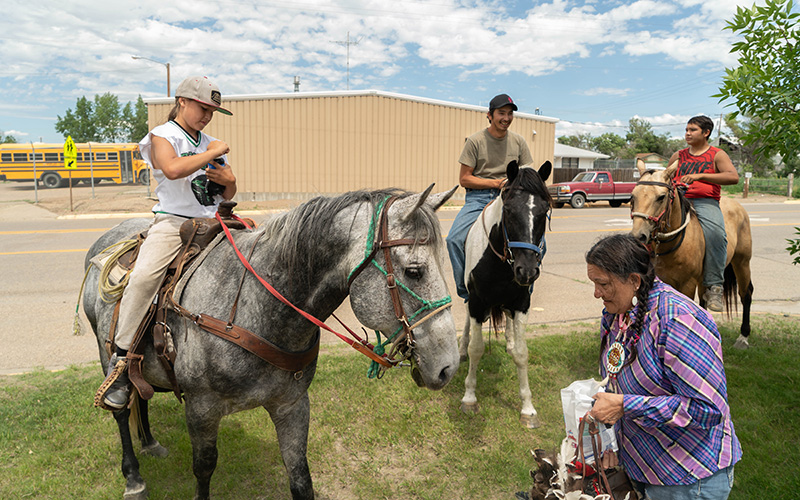
Before the start of a June 26 protest against the Keystone XL pipeline in Poplar, Montana, Anna Four Bear offers doughnut holes to riders (from left) Lance Blackhorn, Thomas Holmes and Kaden Lambert. (Photo by Tilly Marlatt/News21)
The flood of non-native workers into oil-rich regions on or near reservations makes it even more difficult for law enforcement agencies to cooperate with one another, said Meg Singer, the Indigenous Justice Program manager with the American Civil Liberty Union’s Montana chapter in Missoula.
Members of the Fort Peck Reservation in Montana said they are concerned about the upcoming Keystone XL pipeline, which will carry oil from western Canada through Montana into Illinois and Texas, and bring more workers into the area to build it.
TransCanada plans to build man camps for the project this fall, with pipeline construction starting in 2019, according to a letter from the Bureau of Oceans and International Environmental and Scientific Affairs to the Fort Peck Reservation. TransCanada did not respond to multiple requests for comment from News21.
One member of the Fort Peck Reservation Tribal Council recently posted on social media that, according to a meeting with TransCanada, there are tentative plans to set up a man camp 40 miles from the reservation in Hinsdale, Montana, that will house 600 to 900 pipeline workers. The council member added that TransCanada plans to conduct background checks, drug-test workers and institute a code of conduct.
Chris Martinez, an oil worker in Williston, blamed the lack of background checks for the culture of racism demonstrated during production peaks in the Bakken formation. As oil prices go up, companies need more and more workers, and “that’s when you’re going to bring in quantity over quality,” he said.
Martinez said he believes his company will do a better job at “weeding out those bad eggs” in the next oil boom. Martinez is hopeful other companies will do the same, but “some companies who will hire 50 to 100 guys at a time and bring them over here, and it just gets trashed,” he said.
“Those man camps are indescribable, the stuff that happens, there are shootings, stabbings, rapes, fights, extreme amounts of drugs, alcohol. When you work 12 to 16 hours a day and you’re away from your family, and you have all this money, and you go home, that’s when they start making those decisions and it’s bad, it’s really bad.”
Angeline Cheek, a Hunkpapa Lakota and Oglala Sioux activist, community organizer and teacher living in Fort Peck Reservation, took part in a march this spring in Scobey, Montana, to protest the Keystone XL pipeline and the expected man camps.
A group of Scobey residents followed the protesters and yelled at them, saying the pipeline was going through whether they liked it or not. At one point, the residents threatened to scalp Cheek, while local farmers watched the marchers with guns pointed to the sky, Cheek said.
“We had to jump in our vehicles because things got way too dangerous, and there were trucks that kept following us,” Cheek added. “It got very scary until we crossed the reservation line.”
During the previous Bakken oil boom, Cheek said, oil workers had harassed her, her family and friends with racial slurs and threats multiple times. She is protesting the Keystone XL project, she said, because she doesn’t want the past to repeat itself.
These experiences have inspired Cheek to double down on her efforts to advocate against resource extraction taking place in and around Native American communities and man camps. Last month, she organized an anti-man camp walk in Poplar with the intention to hold more marches in various communities throughout the Fort Peck Indian Reservation to spread awareness on what she feels are the dangers associated with the man camps coming into the area.
News21 reporters Kaylen Howard and Tilly Marlatt contributed to this article.
This story was reported in partnership with ProPublica’s Documenting Hate Project, which is collecting reports about hate crimes and bias incidents. If you’ve been a victim or a witness, tell us your story here.
